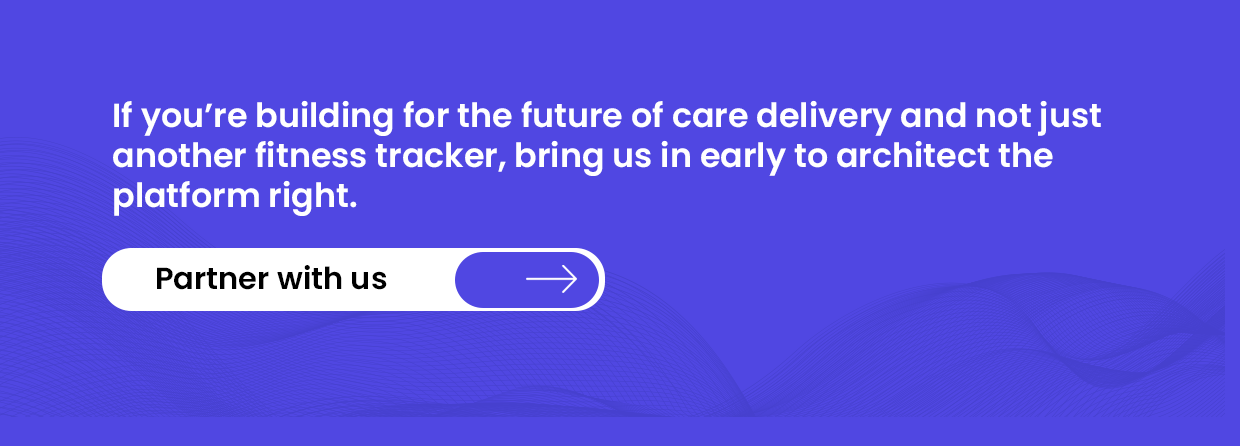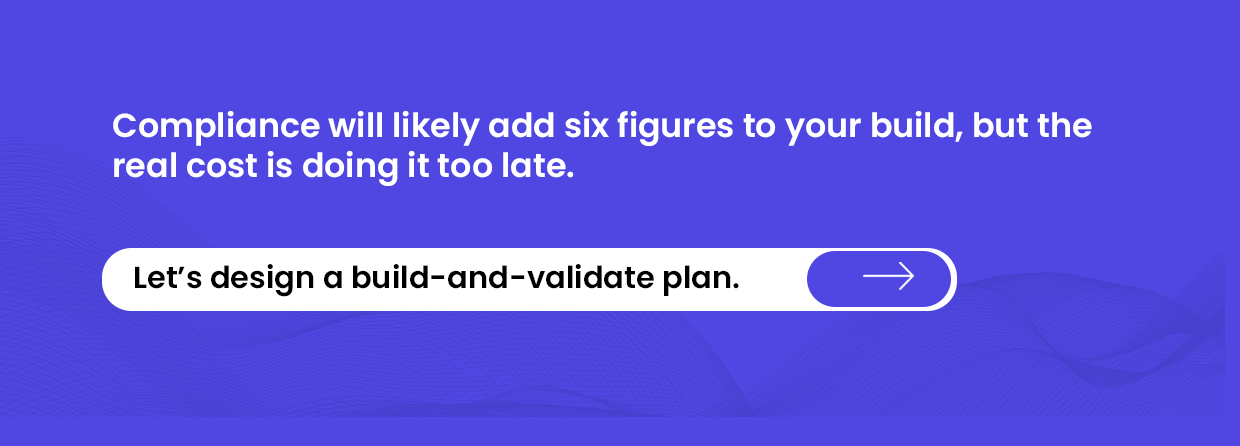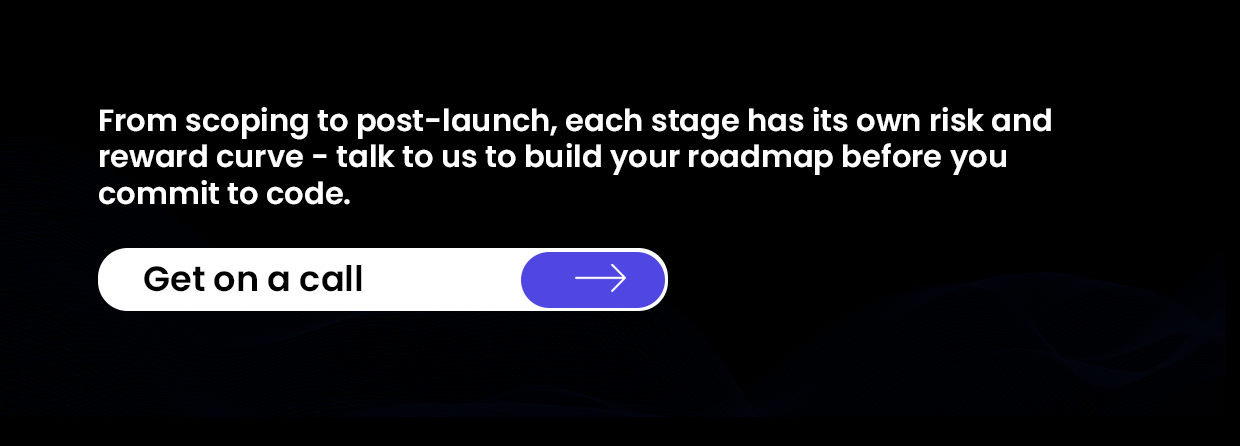
Remote physical therapy is no longer a fringe concept – it’s the new frontline of musculoskeletal care. And leading that revolution is Sword Health, the digital health company using AI, motion sensors, and clinical expertise to deliver recovery at home. But as the world catches up to the promise of digital therapeutics, many healthtech innovators are asking the same question:
What would it take to build something like Sword? And how much would it actually cost?
This article breaks it all down.
Whether you’re an early-stage founder building an MSK recovery platform or a healthcare provider looking to digitize physical therapy services, understanding the costs behind Sword’s tech isn’t just about line items – it’s about planning the right MVP, avoiding clinical landmines, and creating a product that can scale across patients, providers, and payers.
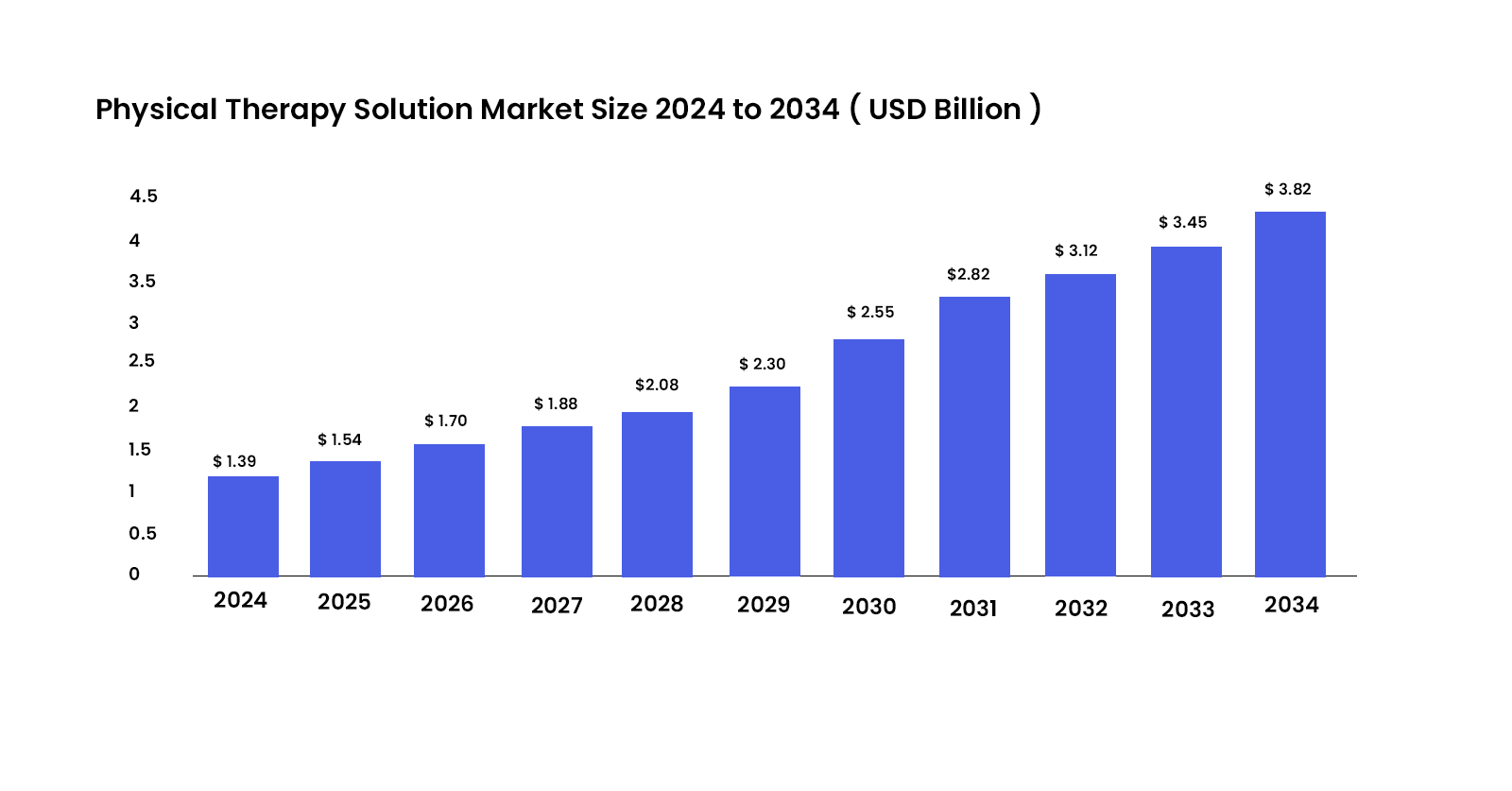
From AI-driven care plans to sensor integration, secure data infrastructure, and clinician dashboards – we’ll explore what it takes to bring a Sword-like product to life, and what kind of budget you need to make it real.
Why Remote Physical Therapy is Gaining Serious Momentum
The rise of remote physical therapy isn’t a pandemic-era blip – it’s a long-overdue transformation in how musculoskeletal care is delivered. Digital solutions are proving they can match, and in some cases surpass, in-person outcomes – while saving time, lowering costs, and making therapy accessible to people who would otherwise skip it altogether.
In a study published in Nature Digital Medicine, Sword Health’s digital PT program was found to be as clinically effective as in-person care, but with double the engagement and a 50% lower dropout rate. That level of stickiness is critical in MSK treatment, where adherence often determines success.
Even traditional payers and providers are leaning in. According to studies, over 80% of therapists now support telehealth as a complement to in-person care, especially for chronic pain and post-surgical rehab.
What’s driving this shift?
- Access: Patients in rural or underserved areas can now receive care without travel or long wait times.
- Personalization: AI-backed systems can adjust therapy plans in real-time, based on sensor feedback and progress tracking.
- Cost-effectiveness: A study by Sword Health estimates their remote programs save employers an average of $2,472 per patient by reducing unnecessary imaging, surgeries, and missed work days (Sword Health, 2024).
And the market is growing. Analysts project the global RPM market is projected to reach $56.94 billion by 2030, driven by aging populations, rising employer adoption, and breakthroughs in motion-sensing and real-time biofeedback technologies. In short, digital PT isn’t just a nice-to-have – it’s becoming the competitive standard for any health system, benefits provider, or tech-enabled clinic serious about MSK care.
How Much Does it Cost to Build an App Like Sword Health?
Building a digital physical therapy app like Sword Health involves more than just video calls and reminders. You’re combining clinical-grade UX, AI-driven personalization, secure health data infrastructure, and – in Sword’s case – sensor integrations. That means your development cost will vary based on how ambitious your first release is.
Here’s a breakdown based on complexity:
Basic MVP
Designed to validate core functionality like remote sessions, user onboarding, and progress tracking – without sensors or AI just yet.
- Key Features: Patient sign-up, exercise video library, therapist dashboard, messaging, session tracking
- Tech Needs: Mobile app (React Native or Flutter), basic backend (Firebase, Node.js), HIPAA-compliant auth & data storage
- Estimated Cost: $80,000 – $150,000
- Timeline: 3–4 month
Best for early-stage startups looking to test product-market fit with clinicians and patients.
Mid-Tier Platform
Includes machine learning-based personalization, basic wearable integration (e.g. Apple Watch), and deeper clinician analytics.
- Key Features: AI-driven plan recommendations, session reminders, wearable tracking (steps, movement), outcomes dashboard
- Tech Needs: ML model integration, third-party APIs (Apple HealthKit, Fitbit, Google Fit), secure cloud backend
- Estimated Cost: $180,000 – $300,000
- Timeline: 5–7 months
Best for teams pursuing B2B2C (benefit provider) partnerships or pilot deployments.
Enterprise-Ready Solution (Sword-Level)
Feature-complete platform with proprietary sensor tech, real-time biofeedback, multi-role portals, clinical reporting, and international compliance (HIPAA, GDPR).
- Key Features: AI + sensors for motion tracking, therapist-patient live interactions, real-time feedback engine, EMR/EHR integration, employer dashboards, reporting
- Tech Needs: Custom hardware API integration, computer vision models, multi-region cloud hosting, SOC 2 + HIPAA-grade security
- Estimated Cost: $400,000 – $750,000+
- Timeline: 8–12 months
Ideal for funded startups or digital health players ready to scale across healthcare systems and global regions.
A smart way to manage costs is by staging your build – starting with an MVP focused on engagement and adherence, then layering in AI and sensors once your workflows are validated.
Core Features You’ll Need to Compete in the Digital Physical Therapy Market
If you’re aiming to build something like Sword Health, you’re not just developing a health app – you’re creating a digital therapeutic. That means your product has to be as engaging as a fitness app, as clinically sound as a hospital workflow, and as seamless as a consumer-grade mobile experience.
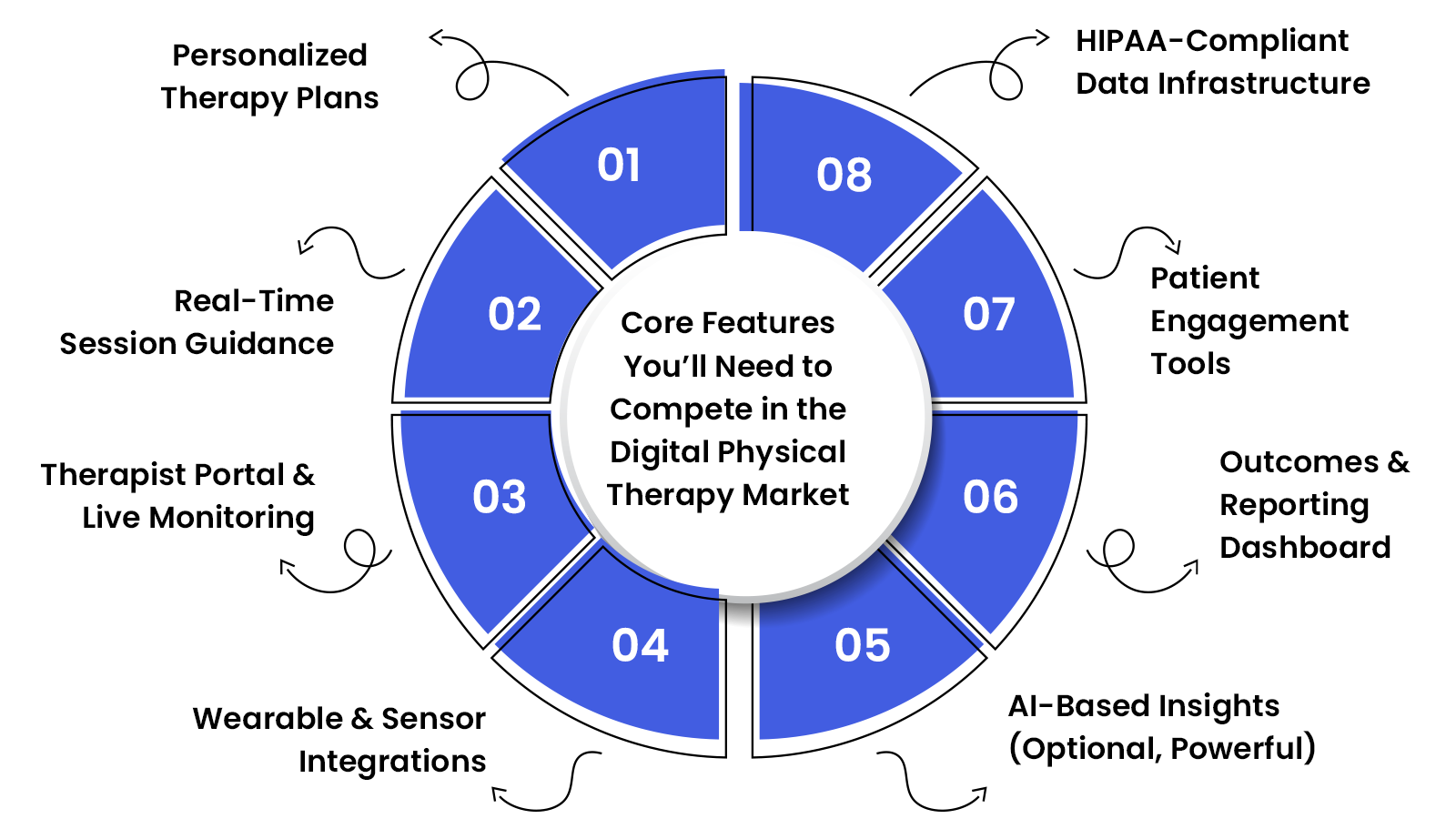
Here are the core features you’ll need to deliver:
- Personalized Therapy Plans
No two patients recover the same way. Your app should allow licensed physical therapists (or AI models) to assign therapy plans based on injury type, pain score, mobility range, and progress data. Plans should auto-adjust based on session feedback and user-reported outcomes. - Real-Time Session Guidance
At the very least, users need video demonstrations of exercises. But to compete seriously, you’ll need to add motion tracking – via smartphone cameras, wearable sensors, or external devices – that can give form corrections and rep feedback in real time. - Therapist Portal & Live Monitoring
PTs should be able to monitor patient adherence, review motion data, send feedback, and adjust plans remotely. Add secure messaging, calendar integration, and notes for a comprehensive remote care experience. - Wearable & Sensor Integrations
Apps like Sword use proprietary sensors, but early-stage builders can integrate with Apple HealthKit, Fitbit, or external sensors to track joint movement, gait, or range of motion. Even basic integrations improve outcomes and trust. - HIPAA-Compliant Data Infrastructure
Every user interaction, video upload, and feedback session needs to be encrypted and compliant. Choose cloud platforms that support HIPAA (like AWS HealthLake, Google Cloud Healthcare API) and ensure session logs are securely stored. - Patient Engagement Tools
Reminders, progress charts, push notifications, gamified milestones – these are essential to keep patients involved in multi-week programs. Engagement = adherence = outcomes. - Outcomes & Reporting Dashboard
Build dashboards for both patients and clinicians that display completed sessions, pain levels over time, range of motion improvements, and therapy milestones hit. These reports become vital for employers, payers, and clinical audits. - AI-Based Insights (Optional, Powerful)
Advanced apps can analyze sensor + behavioral data to predict risk of drop-off, recommend plan changes, or even identify issues like form inconsistency. This is where your app starts to feel truly intelligent – and clinically valuable.
You don’t need all of this on Day 1. But if you’re serious about competing in the digital MSK space, each feature above plays a role in building clinical trust, patient satisfaction, and long-term platform stickiness.
Designing for Trust, Ease, and Clinical Adherence
In digital healthcare, design isn’t just about aesthetics – it’s about behavior. Your UI needs to motivate movement, reinforce progress, and build trust with patients who are doing real rehab without in-person supervision. If your app is confusing, overwhelming, or sterile? Patients won’t stick with it – and outcomes will suffer.
Here’s what matters most in your app’s design:
- Simplicity is Non-Negotiable
Your users may be in pain, recovering from surgery, or unfamiliar with technology. Use large, clear CTAs, simple navigation, and visual metaphors that don’t require a learning curve. A session should feel like a tap-tap-start experience – no digging through menus. - Empathetic UI
Avoid cold, clinical layouts. Use warm tones, encouraging copy, and soft visual transitions. Patients should feel supported, not judged. Reinforce effort, not just outcomes (“You completed 3 exercises today!” vs. “Only 50% of your plan was done”). - Motion-Focused Interactions
For any app involving movement, you’ll need real-time visual feedback – rep counters, posture prompts, green/red indicators. Whether using AI or sensors, UX must mirror what a live therapist would say mid-session: “Straighten your back,” “Almost done,” “Perfect rep!” - Accessibility is Key
Design with limited mobility, age, and visual impairments in mind. That means scalable fonts, high contrast mode, voice instructions, and tap-friendly targets. Sword Health’s demographic includes older adults – your app should too. - Frictionless Onboarding
Make account creation, plan assignment, and first session launch blazingly simple. Use intro walkthroughs, embedded explainers, and minimal upfront data entry. You don’t want to lose a patient before their first stretch. - Progress-Driven Microcopy
Subtle UX copy – like “You’re 5 sessions away from a milestone badge” or “Pain levels dropped 12% since last week” – can drive continued engagement. Make users feel seen and motivated at every step.
Great design in digital physical therapy is about clarity, comfort, and confidence. You’re not just guiding users through a screen – you’re guiding them through recovery.
Tech Stack You’ll Need to Build a Sword Health–Level App
When you’re building a product like Sword Health, your tech stack has to bridge clinical accuracy, real-time interactivity, and long-term scalability. That means balancing three core pillars: user experience, clinical-grade data, and regulatory-grade infrastructure.
Here’s a high-level breakdown of what goes into that kind of build:
Frontend (Patient + Therapist Interfaces)
- React Native or Flutter – Cross-platform mobile development for fast deployment on iOS/Android
- React or Next.js – For therapist dashboards and web admin panels
- Lottie, Reanimated, Framer Motion – To bring motion exercises and feedback to life
- Twilio / Agora / WebRTC – For secure live video sessions between patients and PTs
AI & Personalization Layer
- TensorFlow Lite / PyTorch Mobile – For on-device posture/form detection or rep counting
- OpenCV + Mediapipe – For basic motion tracking via phone camera (if not using hardware sensors)
- Custom ML Models – To suggest adaptive therapy plans based on engagement, pain scores, and recovery velocity
- NLP Models – To analyze patient feedback or symptom check-ins
Wearable + Sensor Integration
- Bluetooth Low Energy (BLE) SDKs – For connecting motion sensors, wearables
- Apple HealthKit / Google Fit – Syncs with existing health data
- Custom APIs – If using proprietary sensors like Sword’s Phoenix system
Backend & Compliance Infrastructure
- Node.js / Django – Fast, scalable backend logic
- PostgreSQL + Redis – For secure user data and session handling
- HIPAA-Compliant Cloud Hosting – AWS HealthLake, Google Cloud Healthcare, or Aptible
- FHIR / HL7 Integration – To sync with EHR systems if going B2B
Data & Analytics
- Amplitude or Mixpanel – For engagement tracking
- Google BigQuery / Snowflake – For long-term outcomes research
- Looker / Tableau – For patient or employer-facing insights dashboards
Security & Legal
- End-to-End Encryption – For video, messages, data logs
- SOC 2, GDPR, HIPAA Protocols – Essential for enterprise adoption
- Audit Trails + Consent Logs – Built-in for clinical and legal reliability
You don’t need to implement everything at once – but your tech choices now should support what you’ll need later. If you’re planning for wearable integration, enterprise compliance, or AI-driven therapy, your foundation must be future-proof from day one.
Compliance, Certifications & Clinical Validation – And What They’ll Cost You
In digital health, especially if you’re building an app like Sword Health, compliance isn’t optional – it’s foundational. You’re dealing with protected health information (PHI), medical-grade data, and outcomes that can impact real patient lives. That means if you’re serious about scaling your product, you’ll need to factor in time and budget for regulatory, clinical, and legal readiness.
Here’s what you’ll likely need to account for – financially and operationally:
1. HIPAA Compliance (U.S. Market)
HIPAA ensures patient data privacy and sets standards for data storage, encryption, access control, and breach handling.
- Estimated Cost: $20,000 – $50,000
- Includes: Policy documentation, risk assessments, third-party audits, and compliant infrastructure (like AWS HealthLake or Aptible)
- Tip: Use platforms that are “HIPAA-ready” to reduce custom overhead.
2. SOC 2 Certification (for Enterprise Sales & Trust)
Required if you plan to work with employers, insurers, or hospital systems – it proves your platform meets security, availability, and confidentiality standards.
- Estimated Cost: $30,000 – $70,000 (initial audit and tech upgrades)
- Timeline: 4–6 months including readiness
- Bonus: It also makes future fundraising and partnerships smoother.
3. Clinical Validation Studies
Sword Health built credibility through peer-reviewed clinical trials (e.g., published in Nature). While optional at MVP stage, validation becomes essential for payer/provider adoption.
- Estimated Cost:
- $25,000 – $100,000+ for pilot studies with therapists + a small cohort
- $150,000 – $300,000+ for IRB-backed clinical trials with academic partners
- Timeline: 6–18 months depending on scope
- ROI: Clinically backed platforms command more trust, better outcomes-based pricing, and faster enterprise deals.
4. GDPR Compliance (for EU Markets)
If you’re targeting patients in the EU, GDPR governs how user data is collected, stored, and used.
- Estimated Cost: $15,000 – $40,000
- Includes: Privacy policy creation, consent flows, data export/delete tooling, DPO services
5. Legal & Regulatory Consulting
You’ll need digital health lawyers to help draft ToS, consent flows, and data use disclosures that meet FDA, HIPAA, or MHRA expectations (depending on geography).
- Estimated Cost: $10,000 – $25,000
- Optional: Add legal review if planning to classify as a “digital therapeutic” under FDA SaMD guidelines.
In total, compliance and validation can add $100,000 to $500,000 depending on your market, maturity stage, and whether you’re going direct-to-consumer or through payers. The bottom line? If you’re building a medical-grade MSK platform, these costs aren’t “extra” – they’re part of what makes your product viable in the first place.
Development Stages and Cost Breakdown
Creating a digital physical therapy platform like Sword Health is a phased process, not a single build. Each stage – from initial discovery to post-launch optimization – plays a distinct role in shaping your product’s viability, user experience, and clinical trustworthiness. Here’s how the journey typically unfolds, along with cost expectations at each step.
The first phase, Discovery and Scoping, involves translating your vision into a clear product plan. This includes stakeholder workshops, feature prioritization, technical feasibility assessments, and mapping the minimum viable functionality. Expect to invest between $10,000 and $20,000 here, with a timeline of two to three weeks. While it’s often tempting to rush this phase, it’s where most scope creep and budget bloat can be prevented later.
Once the strategy is locked in, UX/UI Design brings your product experience to life. This involves designing intuitive flows for both patients and therapists, creating interactive prototypes, and ensuring accessibility – especially for users dealing with pain or limited mobility. This phase typically costs between $15,000 and $30,000 and runs for about three to five weeks.
The core build happens in MVP Development. This is where your engineering team develops the actual application – patient mobile app, therapist portal, backend systems, and compliance-ready data infrastructure. Depending on complexity, MVP development costs range from $80,000 to $150,000 and typically spans three to four months. At this stage, the goal is to validate the core functionality and get the product into users’ hands – not to build every future feature.
For teams aiming to replicate Sword’s advanced capabilities, a follow-up phase often focuses on AI and Sensor Integration. This includes machine learning personalization, motion tracking via smartphone or wearables, and smart rep counting or posture correction logic. Costs for this stage can range from $60,000 to $120,000, depending on the sophistication of the AI and whether external sensor APIs or custom hardware are used.
Once the product is functional, Compliance and Security Hardening becomes critical – especially if you’re planning to sell into enterprises, integrate with payers, or participate in clinical trials. This phase typically includes HIPAA and/or SOC 2 infrastructure setup, encryption layers, consent management, and audit trails. Budget between $40,000 and $100,000+ for this work, which may run concurrently with or follow MVP development.
Finally, successful launches are always followed by a period of Post-Launch Support and Iteration. This includes refining features based on real user feedback, improving UI performance, fixing bugs, and rolling out minor feature updates. A reasonable monthly budget for this stage would be $5,000 to $15,000, with a recommended post-launch support window of at least three months.
In total, a lean but strategically built MVP might cost between $120,000 and $180,000. For a fully featured, clinically validated Sword-like platform, the total investment can range from $400,000 to $750,000 or more – especially when incorporating advanced AI, sensor feedback, and regulatory compliance.
Development Challenges When Building a Digital Physical Therapy Platform
Building a clinical-grade platform for physical therapy isn’t just a technical challenge – it’s a balancing act between usability, accuracy, privacy, and scale. Even well-funded teams can run into setbacks if they underestimate how tightly product decisions are tied to patient outcomes and regulatory expectations.
One of the first challenges is designing for real-world adherence. Your app can be packed with features, but if it’s not intuitive for patients with pain, mobility limitations, or low tech literacy, they won’t use it consistently. The same goes for therapists – your provider dashboard must streamline workflows, not add complexity. Balancing clinical rigor with consumer-level UX takes careful, iterative design.
Another major hurdle lies in motion tracking and real-time feedback. Whether you’re using off-the-shelf wearables or developing your own sensors, collecting clean data and turning it into actionable feedback is hard. There’s also the question of latency, calibration, and user environment – what works well in a demo may fail in a cluttered living room with poor lighting or inconsistent connectivity. And without proper form detection, rep counters and progress charts can become meaningless.
Then comes AI integration, which introduces both opportunity and risk. Building models that adapt therapy plans based on session feedback can dramatically improve personalization. But without enough anonymized data, supervised training, and guardrails, you risk deploying AI that delivers inconsistent or clinically invalid suggestions. This isn’t fitness tech – mistakes can affect someone’s health.
Compliance and data security are another layer altogether. HIPAA, SOC 2, GDPR – these aren’t boxes to tick at the end of the process. They influence how you architect your system from day one. End-to-end encryption, access controls, audit trails, and breach handling protocols all add technical overhead that non-health apps don’t face.
Lastly, there’s the matter of clinical credibility. Sword Health earned trust through peer-reviewed trials and validated outcomes. If you’re planning to sell into hospitals, benefits providers, or enterprise HR teams, you’ll need to follow a similar path. That means planning for pilot studies, outcome tracking, and long-term data collection – even if you’re starting with a lean MVP.
In short, the challenge isn’t just building something that works – it’s building something that patients trust, therapists rely on, and regulators approve. That takes more than just engineering – it takes product discipline, clinical insight, and a strategic roadmap from day one.
How to Scale Smarter and Monetize Better Than Sword Health
If you’re not just building a Sword Health alternative – but aiming to improve on it – you’ll need both a differentiated growth strategy and a sustainable monetization model. Here’s how successful healthtech founders are doing it:
- Start niche, then scale wide
Rather than chasing enterprise clients from day one, consider launching with a focused vertical – like postnatal recovery, athlete rehab, or chronic pain management for seniors. These groups are underserved and more likely to engage deeply with targeted solutions. - Layer value through tiered subscriptions
Offer flexible pricing: free access to basic exercise libraries, mid-tier AI-powered personalized plans, and a premium tier that includes therapist-led sessions, sensor integration, and outcomes tracking. This model supports early adoption while scaling revenue. - Sell to employers with outcome-based pricing
Sword proved the value of cost savings in MSK treatment. You can offer employers a results-based model – charging per recovered employee or per reduction in medical claims – tying pricing directly to ROI. - Partner with outpatient clinics and solo PTs
Independent physical therapists are actively looking for tools to modernize their practices. White-label your platform or license it as a clinical dashboard + patient app combo. It’s a quick way to validate and monetize without enterprise red tape. - Embed AI as a differentiator, not a gimmick
Use AI to drive real-time form correction, smart pain assessment, or predictive recovery timelines. The stronger your clinical AI, the easier it becomes to justify premium pricing and stand out in a crowded market. - Turn outcomes into marketing fuel
Track recovery speed, adherence rates, and engagement metrics – and use this data in your pitch decks, landing pages, and payer negotiations. Quantifiable outcomes drive credibility, investor interest, and sales. - Build a continuous care model
Don’t stop at recovery. Add preventive care programs, mobility tracking, and wellness coaching to extend lifetime value. A patient who finishes PT can still be a long-term user if you offer ongoing support. - Leverage payer and benefits ecosystems
If clinical validation is in place, explore reimbursement through CPT codes or value-based care partnerships. Getting your product covered under employee benefits massively boosts adoption potential.
Why CodingWorkX Is the Right Partner for Building a Digital Physical Therapy Platform
Bringing a Sword Health–level product to life isn’t just about finding a development team – it’s about partnering with people who understand what’s at stake in healthcare innovation. At CodingWorkX, we don’t just ship code. We help founders de-risk complex builds, make smarter product decisions, and launch faster without compromising on compliance, quality, or user trust.
Our team has deep experience building healthtech platforms that combine AI, wearable integrations, secure infrastructure, and clinician-grade UX. We understand what it takes to design for patients recovering from pain or injury, and we know how to build therapist portals that reduce admin overhead while improving care outcomes.
From pre-MVP discovery and UX planning to AI model integration, HIPAA-ready infrastructure, and post-launch iterations – we guide you at every stage. Whether you’re bootstrapping a focused MVP or scaling an enterprise-grade platform with real-time motion tracking and predictive analytics, we tailor our process to your product vision and funding stage.
If you’re serious about building a digital MSK platform that delivers real clinical value – and holds its own against industry leaders – we’re ready to help you build it right.

